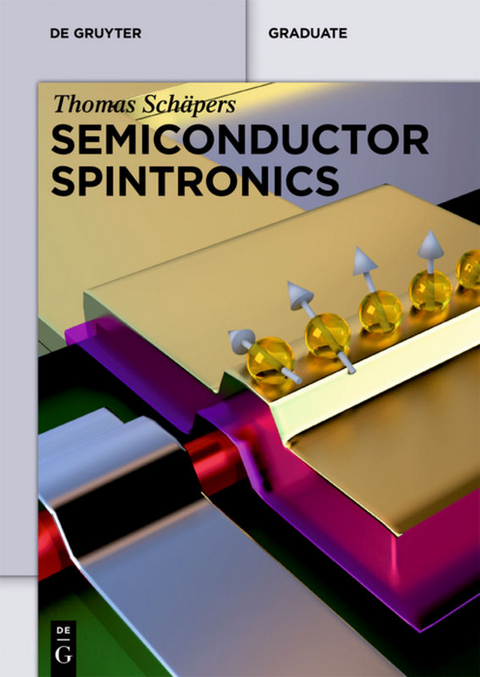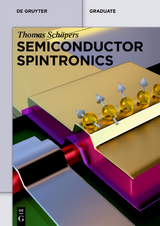Semiconductor Spintronics
De Gruyter (Verlag)
978-3-11-036167-4 (ISBN)
Thomas Schäpers, Research Center Jülich, Germany.
1 Semiconductors
1.1 Overview
1.2 Bulk semiconductors
1.2.1 Band structure
1.2.2 Effective mass
1.2.3 Intrinsic semiconductors
1.3 Doped semiconductors
1.3.1 Mobility
1.4 Layer systems
1.4.1 Semiconductor heterostructures
1.4.2 2-dimensional electron gases
1.4.3 Characteristic length scales
1.5 Quantum wires and nanowires
1.5.1 Electron beam lithography
1.5.2 Semiconductor nanowires
1.5.3 Split-gate quantum point contacts
1.6 Zero-dimensional structures: quantum dots
1.6.1 Transport at small source-drain bias voltages
1.6.2 Transport as a function of source-drain bias voltage
2 Magnetism in Solids
2.1 Overview
2.1.1 Definitions
2.1.2 Magnetization
2.1.3 Classification
2.2 Paramagnetism
2.2.1 Paramagnetism of localized moments
2.2.2 Hund's rule
2.2.3 Pauli paramagnetism
2.3 Collective Magnetism
2.3.1 Exchange interaction
2.3.2 Stoner-model
3 Diluted Magnetic Semiconductors
3.1 Overview
3.2 II-VI diluted magnetic semiconductors
3.3 III-V diluted magnetic semiconductors
3.4 Transport properties of III-V diluted magnetic semiconductors
4 Spin Injection
4.1 Overview
4.2 Resistor model
4.3 Local description of spin injection
4.4 Detection of spin-polarized carriers
4.5 Experiments on optical detection of spin polarization
4.6 Injection through a barrier
4.7 Experiments on spin injectors with interface barriers
5 Spin Transistor
5.1 Overview
5.2 InAs-based 2-dimensional electron gases
5.3 The Rashba effect
5.4 Strength of the Rashba spin-orbit coupling
5.5 Magnetoresistance measurements
5.5.1 Landau quantization
5.5.2 Beating patterns due to the Rashba effect
5.5.3 Gate-control of the Rashba effect
5.6 Dresselhaus term
5.7 Electron interference effects
5.7.1 Weak localization
5.7.2 Weak antilocalization
5.8 Rashba effect in quasi-one-dimensional structures
5.8.1 Rashba effect in planar quasi one-dimensional structures
5.8.2 Rashba effect in tubular structures
6 Magnetic Domains
6.1 Overview
6.2 Formation of domains
6.3 Domain walls
6.4 Magnetic electrodes
6.5 Local Hall effect measurements
6.6 Micromagnetic simulations
6.7 Domain wall motion
6.8 Magnetic race track memory
6.9 Magnetic domain wall logic
7 Spin Hall Effect
7.1 Introductory remarks
7.2 Spin Hall effect basic phenomena
7.3 Spin-Hall effect in GaAs
7.4 Detection of the spin Hall effect by electroluminescence
"Insgesamt ist das Buch von Schäpers eine gelungene Werbung für das Feld der Spintronik, eine gute Grundlage für eine einsemestrige Spezialvorlesung und ein hochmotivierender Lesestoff."
Michael Oestreich in: Physik Journal 16 (2017) No. 8/9, p. 85
| Erscheint lt. Verlag | 25.4.2016 |
|---|---|
| Reihe/Serie | De Gruyter Textbook |
| Zusatzinfo | 100 b/w and 100 col. ill. |
| Verlagsort | Berlin/Boston |
| Sprache | englisch |
| Gewicht | 616 g |
| Themenwelt | Naturwissenschaften ► Physik / Astronomie ► Elektrodynamik |
| Naturwissenschaften ► Physik / Astronomie ► Festkörperphysik | |
| Technik ► Elektrotechnik / Energietechnik | |
| Schlagworte | Electrons • Fluxtronics • magnetism • semiconductors • Solid state physics • spin electronics • Spin transport • Spintronics |
| ISBN-10 | 3-11-036167-1 / 3110361671 |
| ISBN-13 | 978-3-11-036167-4 / 9783110361674 |
| Zustand | Neuware |
| Haben Sie eine Frage zum Produkt? |
aus dem Bereich




